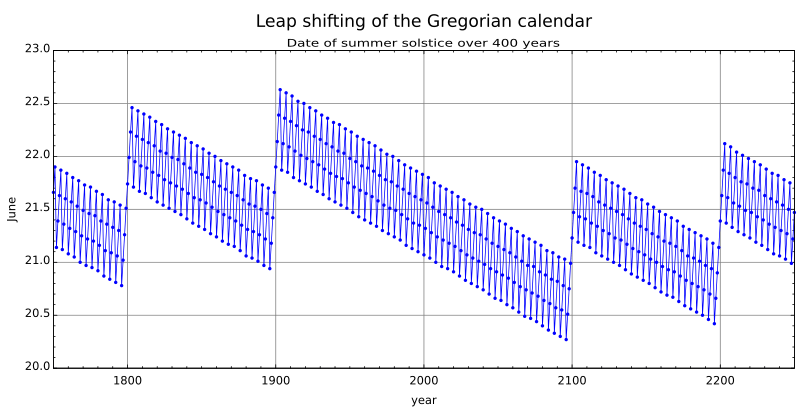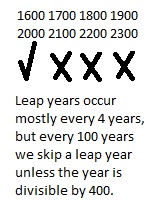Leap year facts for kids
A leap year is a year in which an extra day is added to the Gregorian calendar, which is used by most of the world. While an ordinary year has 365 days, a leap year has 366 days. The extra day, February 29, is added to the month of February. In an ordinary year, February has 28 days, but in a leap year, it has 29 days. The extra 29th day, called a leap day, is the same day of the week as the first day of the month, February 1. Also, in a leap year, the months of January, April, and July all start on the same day of the week.
A leap year comes once every four years. Because of this, a leap year can always be evenly divided by four. For example, 2012 was a leap year. But a year is not a leap year if it can be evenly divided by 100 but cannot also be evenly divided by 400. This is why 1600, 2000, and 2400 are leap years, but 1700, 1800, and 1900 were not.
We have leap years because instead of 365 days, the Earth really takes a few minutes less than 365-1/4 days (365.24219) to go completely around the Sun. Without leap years, the seasons would start one day earlier on the calendar every four years. After 360 years, spring (which usually begins on March 21) would begin on December 21 (which is when winter presently begins).
A number of countries use a lunar calendar (based on the moon, instead of the Sun, like our solar calendar is). They have leap years when they add an extra lunar month. Different calendars add the extra month in different ways.
Julian calendar
On 1 January AUC 709 (45 BC), by edict, Julius Caesar reformed the historic Roman calendar to make it a consistent solar calendar (rather than one which was neither strictly lunar nor strictly solar), thus removing the need for frequent intercalary months. His rule for leap years was a simple one: add a leap day every four years. This algorithm is close to reality: a Julian year lasts 365.25 days, a mean tropical year about 365.2422 days. Consequently, the calendar drifts out 'true' by about three days every 400 years. The Julian calendar continued in use unaltered for about 1600 years until the Catholic Church became concerned about the widening divergence between the March Equinox and 21 March, as explained below.
In the modern calendar, leap day falls on 29 February. This was not always the case: when the Julian calendar was introduced, leap day was handled differently in two respects. First, leap day fell within February and not at the end. Second, the leap day was simply not counted so that a leap year still had 365 days.
The Romans treated leap day as a second sixth day before the Kalends of March, in Latin ante diem bis sextum Kalendas Martias, This bis sextum was translated as 'bissextile': the 'bissextile day' is the leap day and a 'bissextile year' is a year which includes a leap day. This second instance of the sixth day of the Kalends of March was inserted in calendars between the 'normal' fifth and sixth days. By a legal fiction the Romans treated both the first "sixth day" and the additional "sixth day" of the Kalends of March as one day. Thus a child born on either of those days in a leap year would have its first birthday on the following sixth day of the Kalends of March. When, many years later, modern consecutive day counts were laid alongside the Roman dates the sixth day of the Kalends of March fell on 24 February. However, in a leap year the sixth day fell on 25 February because the second sixth day came before the sixth day.
The medieval Church continued the Roman practice which can be illustrated by, for example, the feast of Saint Matthias which used to be celebrated on the sixth day before the Kalends of March in both common and leap years. The calendar for February in the Book of Common Prayer of 1549 shows the position in a normal year when the feast of St Matthias is on the sixth day of the Kalends of March which is alongside 24 February. The position in a leap year is not shown in the Church of England's 1549 Book of Common Prayer but the prior insertion of the second sixth day meant the feast of St Matthias fell on 25 February in leap years. This practice ended in England some time after Henry VIII split from Rome, specifically in the 1662 edition of the Book of Common Prayer. Consecutive day counting has entirely replaced the Roman system. The feast of St Matthias is invariably on 24 February and leap day is shown at the end of February.
The Church and civil society also continued the Roman practice whereby the leap day was simply not counted so that a leap year was only reckoned as 365 days. Henry III of England's Statute De Anno et Die Bissextili of 1236 instructed magistrates to ignore the leap day when persons were being ordered to appear before the court within a year. The practical application of the rule is obscure. It was regarded as in force in the time of the famous lawyer Sir Edward Coke (1552-1634) because he cites it in his Institutes of the Lawes of England. However, Coke merely quotes the act with a short translation and does not give practical examples.
` ... and by (b) the statute de anno bissextili, it is provided, quod computentur dies ille excrescens et dies proxime præcedens pro unico dii, so as in computation that day excrescent is not accounted.'
Gregorian calendar
In the Gregorian calendar, the standard calendar in most of the world, most years that are multiples of 4 are leap years. In each leap year, the month of February has 29 days instead of 28. Adding one extra day in the calendar every four years compensates for the fact that a period of 365 days is shorter than a tropical year by almost 6 hours. Some exceptions to this basic rule are required since the duration of a tropical year is slightly less than 365.25 days. The Gregorian reform modified the Julian calendar's scheme of leap years as follows:
Every year that is exactly divisible by four is a leap year, except for years that are exactly divisible by 100, but these centurial years are leap years if they are exactly divisible by 400. For example, the years 1700, 1800, and 1900 are not leap years, but the years 1600 and 2000 are.
Over a period of four centuries, the accumulated error of adding a leap day every four years amounts to about three extra days. The Gregorian calendar therefore omits three leap days every 400 years, which is the length of its leap cycle. This is done by omitting February 29 in the three century years (multiples of 100) that cannot be exactly divided by 400. The years 1700, 1800, and 1900 were not leap years; neither will 2100, 2200 and 2300. Conversely, the years 1600 and 2000 were leap years as will be 2400. By this rule, the average number of days per year is 365 + 1⁄4 − 1⁄100 + 1⁄400 = 36597⁄400 = 365.2425. The rule can be applied to years before the Gregorian reform (the proleptic Gregorian calendar), if astronomical year numbering is used.
 This graph shows the variations in date and time of the June Solstice due to unequally spaced "leap day" rules. Contrast this with the Iranian Solar Hijri calendar, which generally has 8 leap year days every 33 years. |
The Gregorian calendar was designed to keep the vernal equinox on or close to March 21, so that the date of Easter (celebrated on the Sunday after the ecclesiastical full moon that falls on or after March 21) remains close to the vernal equinox. The "Accuracy" section of the "Gregorian calendar" article discusses how well the Gregorian calendar achieves this design goal, and how well it approximates the tropical year.
Related pages
Images for kids
-
A spinster eagerly awaits the upcoming leap day, in this 1903 cartoon by Bob Satterfield.
See also
 In Spanish: Año bisiesto para niños
In Spanish: Año bisiesto para niños










